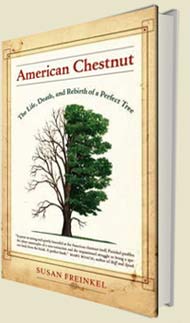
american chestnut:
The Life, Death, and Rebirth
of a Perfect Tree
excerpt
The tree looks like an aging champion struggling to stay upright until the last round. It is badly bruised. A major branch is missing. But it still has a heavyweight’s build and a veteran’s endurance. Perhaps 150 or two hundred years old, this tree is one of the few survivors of a century-long plague that has brought down nearly every mature American chestnut tree from Georgia to Maine. At sixty feet tall and nearly four feet wide, it’s the largest chestnut left in the species’ historic range.
Until recently, the tree had the company of a few other chestnuts in the nearby fence row. One succumbed to the chestnut blight; another was pushed over by a pasturing horse. So now it sits majestically alone, behind a horse-proof fence erected by volunteers. We step through the gate and into the tree’s shrunken kingdom, a shady chaotic patch of yarrow, blackberry bramble and thistles.
It’s soothingly green beneath the tree’s magnificent canopy. The bark is deeply furrowed and all along the main stem are sunken blackish spots, healed scabs from the tree’s epic battle with the chestnut blight. Patches in the crown are brown and dying. The oval saw-toothed leaves are bumpy with bug infestation. Last winter’s storms brought down a branch bigger than a man’s leg, leaving the tree with a lopsided look. “I don’t know how much longer the poor fellow’s going to last,” says the current owner of the land.
Yet, the tree hangs on: sixty-plus feet of blind hope. New shoots sprout from its roots. And the tree remains faithful to the seasonal script, even though it’s a lonely solo performance. Each June, it bursts forth with bushy, cream colored blossoms, undeterred by the absence of other chestnuts to receive the pollen or reciprocate. Each October, the branches dangle dozens of burs, the prickly brown husks that are supposed to protect the tree’s precious cargo, its seeds. The ground around the tree is littered with the dried-out burs of last fall. I nudge a few open with the toe of my shoe. Every single one is empty.
I’m not someone who hugs trees or talks to them. Yet in such a situation, it’s easy to anthropomorphize. When I press my hand flat against the weathered trunk, I could swear I feel life itself pulsing inside.
